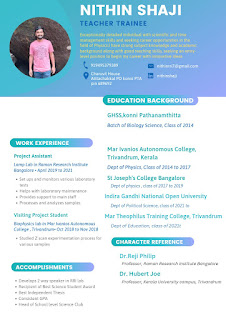Navigating the Path of a Student Teacher: Building a Comprehensive Portfolio Introduction
Becoming a teacher is a transformative journey that requires dedication, passion, and a commitment to lifelong learning. As a student teacher, one of the essential components of your journey is creating a portfolio, a comprehensive record of your experiences, reflections, and growth throughout your Bachelor of Education (B.Ed) program. In this blog, I will share my personal experiences and insights on the process of creating a portfolio as per the B.Ed curriculum requirement.
Understanding the Purpose of the Portfolio
Before diving into the portfolio creation process, it's crucial to grasp why it's an integral part of the B.Ed curriculum. The portfolio serves as a reflection of your development as a teacher, documenting your achievements, challenges, and the strategies you employ to enhance your teaching skills. It is not just a compilation of materials; rather, it's a narrative of your teaching journey.
Collecting Evidence
The first step in creating a portfolio is gathering evidence of your experiences as a student teacher. This evidence can include lesson plans, student work samples, classroom observations, self-assessments, and feedback from mentors and peers. As you progress through your practicum placements, be diligent about collecting these artifacts. Don't wait until the last minute to scramble for evidence.
Reflecting on Your Practice
Reflection is the heart of a teaching portfolio. It's where you analyze and evaluate your teaching experiences, highlighting your growth and areas for improvement. Each piece of evidence should be accompanied by a thoughtful reflection that demonstrates your understanding of the pedagogical principles you've applied and the impact they had on student learning.
Organizing Your Portfolio
A well-organized portfolio is not only easier for assessors to review but also a testament to your professionalism. Consider dividing your portfolio into sections such as philosophy of teaching, lesson plans, classroom management, assessment strategies, and professional development. Use tabs, dividers, or digital organization tools to keep everything neat and accessible.
Showcasing Your Growth
Your portfolio should tell a story of your journey as a student teacher. Include evidence from your initial practicum experiences and compare them to your more recent ones. Highlight the changes in your teaching methods, classroom management, and interactions with students. This demonstrates your ability to adapt and grow as an educator.
Seek Feedback
Don't hesitate to seek feedback from mentors, professors, and peers while developing your portfolio. Their insights can help you refine your reflections and ensure that your portfolio effectively demonstrates your development as a teacher. Constructive criticism is a valuable tool for improvement.
Emphasizing Impact on Student Learning
A critical aspect of your portfolio is demonstrating the impact of your teaching on student learning. Use evidence to show how your lessons have engaged and helped students achieve their learning goals. Share stories and anecdotes that highlight the positive changes you've made in your students' educational journeys.
Professionalism and Attention to Detail
The presentation of your portfolio matters. Ensure that it is free of grammatical errors, typos, and formatting inconsistencies. A well-polished portfolio reflects your professionalism and attention to detail, qualities that are highly valued in the teaching profession.
Conclusion
Creating a portfolio as a student teacher is not just a requirement; it's an opportunity to reflect on your journey, showcase your growth, and prepare for your future as an educator. As you compile evidence, reflect on your experiences, and organize your portfolio, remember that it's a dynamic document that evolves with you. Use it as a tool for self-assessment, self-improvement, and as evidence of your readiness to embark on a fulfilling teaching career. The effort you put into creating a comprehensive portfolio will undoubtedly be a valuable investment in your professional development.

.jpeg)
.jpeg)


Comments
Post a Comment